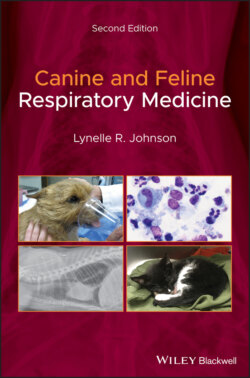Читать книгу Canine and Feline Respiratory Medicine - Lynelle Johnson R., Lynelle R. Johnson - Страница 52
Airway Wash Cytology
ОглавлениеNormal tracheal wash cytology is composed of ciliated columnar to cuboidal epithelial cells and rare macrophages or inflammatory cells. Normal BAL cytology contains primarily alveolar macrophages (65–75%), with 5–10% neutrophils, lymphocytes, and eosinophils; although in a cat, 18–25% eosinophils can be normal (Figure 2.25). Normal macrophages can exhibit variable appearances depending upon stimuli present within the lung, such as infection or inflammation. Activated macrophages contain intracellular inclusions, can appear foamy, and may be engulfing granulocytes or particulate matter in comparison to quiescent macrophages. Normal BAL cell counts have been reported for the dog and cat and are approximately 300–400 cells/μl. Higher cell counts and/or an altered percentage of cells present within the lavage fluid are indicative of lower respiratory tract pathology. Little progress has been made in standardizing the procedures for BAL, for handling fluid after collection, or for interpreting cell counts. Inflammatory cells can be trapped in mucus and straining a sample will artificially lower cell numbers. While hypercellular BAL fluid could be considered suggestive of an inflammatory process, not all laboratories report a total nucleated cell count and some do not supply a differential cell count. Whenever possible, these numbers should be requested from the clinical pathologist to aid in interpretation.
Figure 2.25 Cytocentrifuge of a normal bronchoalveolar lavage sample (40×) reveals primarily macrophages (65–75%), with the remaining percentage made up of neutrophils, lymphocytes, and eosinophils.
Suppurative inflammation is characterized by >10% neutrophils and can represent pure inflammation, as in chronic bronchitis in the dog or cat, or can be an indicator of infection, as with pneumonia. The finding of degenerate neutrophils containing intracellular bacteria is a reliable indicator of bacterial pneumonia. Pyogranulomatous inflammation (activated macrophages and increased neutrophils) can be an indicator of fungal disease, and samples should be closely screened for cytologic evidence of fungal organisms (see Chapter 6). This type of inflammation can also be seen with very chronic bacterial pneumonia or bronchiectasis.
Eosinophilic inflammation is characteristic of some forms of feline asthma and can also be found with airway parasitism due to Aelurostrongylus, Capillaria, Crenosoma, or Paragonimus, in heartworm disease, or with larval migration of gastrointestinal parasites (Toxocara). Airway eosinophilia is a prominent feature of eosinophilic bronchopneumopathy in dogs.
Hemorrhagic inflammation can be found with rodenticide intoxication (vitamin K antagonists), heartworm or Paragonimus infection, foreign body, or trauma. Neoplasia and thromboembolic disease can also result in pulmonary hemorrhage. Evidence of previous airway hemorrhage (indicated by macrophages ingesting red blood cells or hemosiderin‐laden macrophages) can be found in some dogs with congestive heart failure, lung neoplasia, or with exercise‐induced pulmonary hemorrhage.
In rare instances, malignant cells can exfoliate into the airways with pulmonary carcinoma (primary or metastatic) or in pulmonary involvement with lymphoma and will be detected in BAL fluid. Characteristics of malignancy are similar to those in other tissues, including loss of contact inhibition, variation in cell size or nuclear size and shape, increased nuclear‐to‐cytoplasmic ratio, basophilia, multi‐nucleate cells, or frequent cells undergoing mitosis. Neoplastic transformation can be difficult to confirm because dysplastic changes associated with severe inflammation can mimic neoplastic atypia. In addition, some lung tumors have a necrotic center or can become infected, which can complicate interpretation of abnormal‐appearing cells or the presence of bacteria. Review of several samples can be required to confirm the presence of an underlying neoplasm. If a mass lesion is noted in the airway lumen during bronchoscopic examination, an endoscopic biopsy sample should be obtained.
